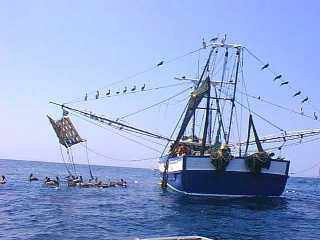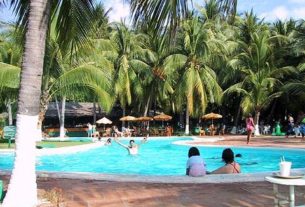
It is occurring at an alarming rate — native populations of fish, mammals and other Sea of Cortez (or Gulf of California) inhabitants are declining, some to the point of near-extinction. Most people familiar with the issue agree on the reasons: commercial overfishing; bycatch victims of all species in commercial and local fishermen’s nets; environmental pollution and lack of enforcement of regulations meant to prevent all of the above.
So what can be done about it?
Many believe the first step is to overturn NOM-029. A good article describing the basics of NOM-029 and the danger it poses to the health of all organisms that call the Sea of Cortez home is “Marine Life Threatened in Sea of Cortez” at ESPN.com.
The second step may be to make it illegal for commercial fishermen to harvest and sell bluefin tuna and other sought-after, endangered species from the Sea of Cortez. Government-funded fish farms could be established in conjunction with Japan (the main importers of Baja fish) to meet the demand for supply and give Mexican entrepreneurs an opportunity for new businesses.
Destructive fishing practices and NOM-029
NOM-029 became a law in 2007. But many say this bill legalizes destructive fishing practices in the Sea of Cortez.
Called a conservation catastrophe by The Billfish Foundation, NOM-029-PESCA-2006 is a measure that allows commercial longlining in coastal waters of the Sea of Cortez. Prior to NOM-029, commercial vessels were not allowed to fish for or possess marlin, sailfish, dorado (mahi-mahi in Spanish) and other protected species within 50 miles of the coastline. Only recreational anglers were allowed to fish in these protected zones.
Promoters of the bill claim it is intended to protect a select few endangered species, such as the Giant Ray and Hammerhead Shark. Opponents doggedly fighting NOM-029 are outraged that it allows for activities by commercial fishermen that are leading to the decimation of other protected populations of fish in the Sea of Cortez.
Here is one days worth of destruction by a few commercial fishermen totaled up by Sea Watch, a conservation organization located in La Paz.
“Two boats caught around 400 dorado – we watched them retrieve approximately 110 hooks and there were 53 dorado on each of them. Each boat had 5 km of longline with 600 to 700 baited hooks in the water. Multiply these numbers by the numbers of boats fishing and you suddenly have 5,000 to 10,000 small dorado being taken from Baja waters on any given day.”
More information and photographs are posted on the Sea Watch website such as this article: “Shark Norma 029 Continues to Kill Protected Species.”
Although NOM-029 is currently the law, the battle to save the marine life of the Sea of Cortez is hardly over. Laws, especially when counter-productive, can be overturned or amended.
The following three paragraphs – quoted from this article in the Los Angeles Times (May, 2007) “Sharks’ Law Problem is ‘Bycatch’ Loophole” – illustrate both sides of the issue and why NOM-029 is considered a misguided attempt to protect species such as blue and hammerhead sharks and the giant ray in the Sea of Cortez.
Paragraph 1:
“NOM-029 limits fishing pressure through permits and imposes gear and area restrictions designed to ensure sustainability. It bans the capture of certain sharks and rays; phases out of drift gill-nets; and outlaws finning, or slicing fins from sharks and throwing their writhing bodies overboard.”
Why Green Peace currently supports the bill
Paragraphs 2 and 3:
“But it does not adequately guard against exploitation of “bycatch” species such as dorado, marlin and sailfish – species that gave rise to sportfishing-related tourism and supposedly are off-limits to commercial fishermen.
“Long-line hooks do not discriminate. Marlin, sailfish and dorado fetch a higher price than sharks, which are already depleted. So it’s reasonable to assume the bycatch species are really what the fishermen are after.”
Why opponents are doggedly fighting it
If you choose to help The Billfish Foundation, Sea Watch and other organizations fighting for the survival of the natural wonderland known as the Sea of Cortez and to overturn NOM-029, please see the suggestions outlined at the end of this article.
Ban the harvest and sale of Pacific bluefin tuna and create sustainable fish farms?
Amending the current version of NOM-029 may not be enough to protect marine life in the Sea of Cortez. Regardless of the wording on the books, it is commonplace for commercial fishermen and shrimpers to routinely violate regulations yet suffer no consequences.
This past May, a resident of San Marcos Island in Baja California Sur reported the following account, “Purse seiners (net boats) netted all of the yellowtail in the Isla San Marcos area last week. The last boat reportedly had seven tons aboard!” When I lived in Central Baja it was commonplace to witness shrimpers and net boats violating regulations — fishing too close to shore and for days on end.”
Banning the sale and harvest of bluefin tuna and other in-demand species may be a necessary step to insure the future of the multi-million dollar sportfishing and tourism industry and to support efforts at ocean conservation.
Peru faced a similar threat and recently issued a presidential order that decommercializes the harvest and sale of marlins and sailfish. For more information, read the online article: “TBF Assists a Nation’s President Set a New Standard for Billfish Conservation.”
Can Mexico follow suit? Can we stop commercial fishing of at-risk fish populations, then focus efforts on creating sustainable fish farms to meet the demand for supply? The demand for fish from the seas of Baja and throughout the world is expected to increase annually, reaching 120 million tons of fish a year by 2010, according to this article: “Aquaculture is Needed to Satisfy Global Demand for Fish.”
Fish farming is a viable — and maybe the only — alternative to destructive fishing practices. Tuna farming is an established industry in Baja California, and is one of the fastest growing forms of aquaculture in the world today.
A 2005 report titled “2Sustainability Assessment of Capture-Based Tuna Aquaculture in Mexico” written by the MSATAM Team (Marine Science Assessment of Tuna Aquaculture in Mexico) states, “… tuna farming in large nearshore net pens has expanded rapidly along the Baja Pacific coast north and south of the Tijuana-Ensenada Corridor. Mexican tuna are now estimated to comprise 10% of global tuna production (35,000 tons).”
Farmed tuna that use wild-caught fish (primarily Pacific bluefin tuna) for stock, which are then raised in pens and fed small fish such as sardines, are sought-after for sushi due to the higher oil content of the fish. High-quality seems to fetch a high price. According to the article above, “Farm gate prices for Mexican farmed tuna are currently reported to be $12,000/ton.”
This article “Say Hola to Tuna From Mexico!” explains that fish farms in Mexico should more accurately be called “ranches” or “capture-based tuna farming” because wild tuna are used for both stock and feeds. It states, “A true ‘farm’ would be one in which fish are raised from egg to adult stages in captivity….”
The goal of environmental organizations and scientists is to push for sustainable, ecologically-safe fish farms. Tuna farms that use wild stock can devastate the habitat they come from. In the U.S., capture fisheries have decimated tuna stock in the Atlantic. Researchers and environmentalists are trying to prevent that from happening in the Pacific as well.
Barry A. Costa-Pierce, a Professor of Fisheries and Aquaculture at the University of Rhode Island states, “It is urgent that we develop an internationally credible scientific basis for sustainable tuna farming that could decrease pressure on tuna stocks, while also being environmentally and socially sustainable.”
Could Mexico partner with Japan to create sustainable fish farms?
Much of the demand for Baja fish comes overseas from Japan, where Pacific bluefin tuna can sell for as much as $45 USD a pound. This demand and a price for supply keep destructive fishing practices — including shrimp harvesting — alive and well in the Sea of Cortez.
To halt the damage — and inevitable catastrophic end results — Mexico could make the export of fish from the Sea of Cortez illegal. Japan could assist in the development of fish farms to meet their demand for supply, in partnership with Mexico. Japan and Mexico are already successful business partners, with joint-ownership of the Exportadora de Sal (ESSA saltworks located south of Guerrero Negro) by Mitsubishi and the Mexican government.
Even better news is that Japan has perfected techniques for sustainable fish farming of bluefin tuna; the culmination of three decades of experimentation and research. The process is described in the article, “Fish-Farming Breakthrough.” It states, “The fish (bluefin tuna) were 100% farmed, meaning that the eggs came from parents that had also been artificially bred. The bluefin were then farmed from hatching to adulthood. It took three decades of work to produce the first successfully 100% farmed bluefin tuna in the world.”
Fish farms are not a problem-free solution, but they are a viable alternative to commercial overfishing in the Sea of Cortez. Farmed fish could meet the demand for at-risk species whose wild stock is being depleted in increasing numbers and at a rate that could eventually lead to extinction — such as Pacific bluefin tuna. Fish farms could target the intended species for sale, rather than destructive fishing practices that incidentally kill thousands of forms of sea life in great numbers in pursuit of it.
For more information and to sign-up to receive news releases on current happenings, visit the Billfish Foundation website.

